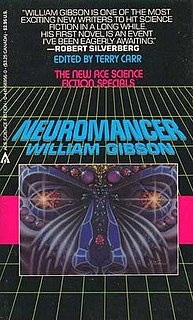
William Gibson: A Literary Companion is a 2011 book by Tom Henthorne, published by McFarland & Company, focused on analyzing the works of American science-fiction writer William Gibson. [1]

William Gibson: A Literary Companion is a 2011 book by Tom Henthorne, published by McFarland & Company, focused on analyzing the works of American science-fiction writer William Gibson. [1]

Cyberpunk is a subgenre of science fiction in a dystopian futuristic setting that tends to focus on a "combination of lowlife and high tech", featuring futuristic technological and scientific achievements, such as artificial intelligence and cybernetics, juxtaposed with societal collapse, dystopia or decay. Much of cyberpunk is rooted in the New Wave science fiction movement of the 1960s and 1970s, when writers like Philip K. Dick, Michael Moorcock, Roger Zelazny, John Brunner, J. G. Ballard, Philip José Farmer and Harlan Ellison examined the impact of drug culture, technology, and the sexual revolution while avoiding the utopian tendencies of earlier science fiction.

Neuromancer is a 1984 science fiction novel by American-Canadian writer William Gibson. Considered one of the earliest and best-known works in the cyberpunk genre, it is the only novel to win the Nebula Award, the Philip K. Dick Award, and the Hugo Award. It was Gibson's debut novel and the beginning of the Sprawl trilogy. Set in the future, the novel follows Henry Case, a washed-up hacker hired for one last job, which brings him in contact with a powerful artificial intelligence.

William Ford Gibson is an American-Canadian speculative fiction writer and essayist widely credited with pioneering the science fiction subgenre known as cyberpunk. Beginning his writing career in the late 1970s, his early works were noir, near-future stories that explored the effects of technology, cybernetics, and computer networks on humans—a "combination of lowlife and high tech"—and helped to create an iconography for the information age before the ubiquity of the Internet in the 1990s. Gibson coined the term "cyberspace" for "widespread, interconnected digital technology" in his short story "Burning Chrome" (1982), and later popularized the concept in his acclaimed debut novel Neuromancer (1984). These early works of Gibson's have been credited with "renovating" science fiction literature in the 1980s.
Bobby Newmark is one of the main characters in the William Gibson novel Count Zero. His handle in the Matrix is "Count Zero", from which the novel derives its name. Newmark is one of several Gibson characters who live through information.

Edmund Gibson was a British divine who served as Bishop of Lincoln and Bishop of London, jurist, and antiquary.

Molly Millions is a recurring character in stories and novels written by William Gibson, particularly his Sprawl trilogy. She first appeared in "Johnny Mnemonic", to which she makes an oblique reference in Neuromancer. She later appeared in Mona Lisa Overdrive under the name "Sally Shears".
Southern Ontario Gothic is a subgenre of the Gothic novel genre and a feature of Canadian literature that comes from Southern Ontario. This region includes Toronto, Southern Ontario's major industrial cities, and the surrounding countryside. While the genre may also feature other areas of Ontario, Canada, and the world as narrative locales, this region provides the core settings.
"The Belonging Kind" is a science fiction short story by cyberpunk authors William Gibson and John Shirley. It was first published in the horror anthology Shadows 4 edited by Charles L. Grant in 1981, later to be included along with several other stories in Gibson's collection Burning Chrome.

Blackwood's Magazine was a British magazine and miscellany printed between 1817 and 1980. It was founded by the publisher William Blackwood and was originally called the Edinburgh Monthly Magazine. The first number appeared in April 1817 under the editorship of Thomas Pringle and James Cleghorn. The journal was unsuccessful and Blackwood fired Pringle and Cleghorn and relaunched the journal as Blackwood's Edinburgh Magazine under his own editorship. The journal eventually adopted the shorter name and from the relaunch often referred to itself as Maga. The title page bore the image of George Buchanan, a 16th-century Scottish historian, religious and political thinker.
"The Winter Market" is a science fiction short story written by William Gibson and published as part of his Burning Chrome short story collection. The story was commissioned in 1985 by Vancouver Magazine, who stipulated that Gibson – who at the time was "unquestionably the leading Vancouver author on the international literary scene" – set it in the city.

Node Magazine is a literary project in the guise of a fictional magazine created to annotate the novel Spook Country by William Gibson.

The works of William Gibson encompass literature, journalism, acting, recitation, and performance art. Primarily renowned as a novelist and short fiction writer in the cyberpunk milieu, Gibson invented the metaphor of cyberspace in "Burning Chrome" (1982) and emerged from obscurity in 1984 with the publication of his debut novel Neuromancer. Gibson's early short fiction is recognized as cyberpunk's finest work, effectively renovating the science fiction genre which had been hitherto considered widely insignificant.

Vaux-en-Beaujolais is a commune in the Rhône department in eastern France. It is the inspiration for the fictional town of Clochemerle.
Rei Toei is a fictional character in the Bridge trilogy of speculative fiction novels by William Gibson. Rei is introduced as the title character in Gibson's 1995 novel Idoru, as an artificial intelligence, an embodied agent simulating a human female idol singer. A personality construct which adapts and learns from her interaction with humans, she irresistibly attracts data analyst protagonist Colin Laney.
"A Diamond Guitar" is a short story by Truman Capote, first published in Harper's Bazaar in 1950; it is noted as one of his better quality early short stories. The title refers to the prize possession of the younger man, a rhinestone-studded guitar; the guitar serves as the key image of the story.

The Shakespeare authorship question is the argument that someone other than William Shakespeare of Stratford-upon-Avon wrote the works attributed to him. Anti-Stratfordians—a collective term for adherents of the various alternative-authorship theories—believe that Shakespeare of Stratford was a front to shield the identity of the real author or authors, who for some reason—usually social rank, state security, or gender—did not want or could not accept public credit. Although the idea has attracted much public interest, all but a few Shakespeare scholars and literary historians consider it a fringe theory, and for the most part acknowledge it only to rebut or disparage the claims.

The novel in Scotland includes all long prose fiction published in Scotland and by Scottish authors since the development of the literary format in the eighteenth century. The novel was soon a major element of Scottish literary and critical life. Tobias Smollett's picaresque novels, such as The Adventures of Roderick Random and The Adventures of Peregrine Pickle mean that he is often seen as Scotland's first novelist. Other Scots who contributed to the development of the novel in the eighteenth century include Henry Mackenzie and John Moore.

Scottish literature in the nineteenth century includes all written and published works in Scotland or by Scottish writers in the period. It includes literature written in English, Scottish Gaelic and Scots in forms including poetry, novels, drama and the short story.
Literary Garland was a Montreal-based literary magazine published by John Lovell and John Gibson. During its run from 1838 to 1851, it was the most successful literary magazine in Canada, and started the careers of many prominent Canadian literary authors and composers.